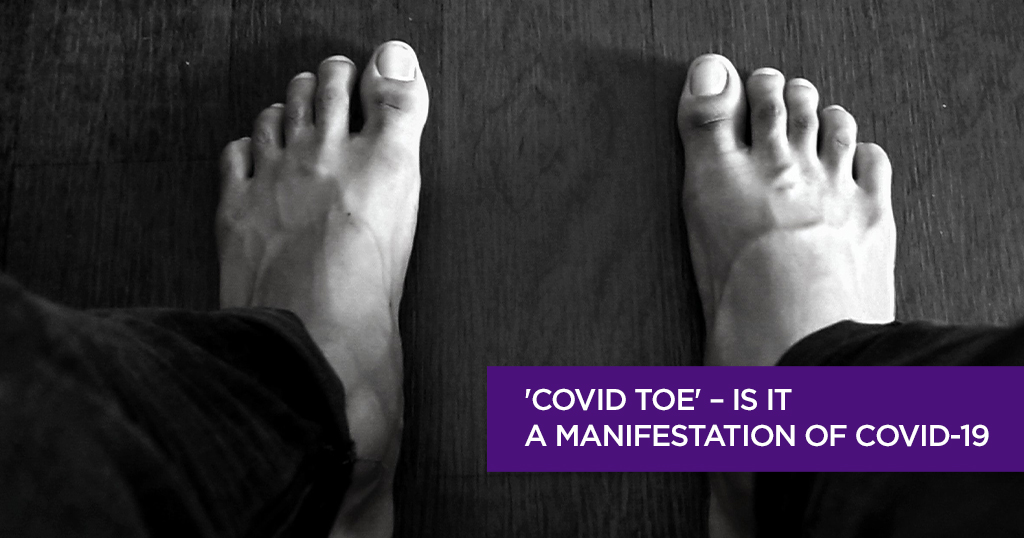

The novel coronavirus emerged last year in the city of Wuhan, China, and scientists all over the world are still struggling round the clock to learn more about the novel coronavirus. Months after this deadly outbreak, scientists came up with another symptom associated with the Coronavirus infection that is known as the “COVID toe”.
COVID toe is a dermatological manifestation that closely resembles Chilblains or “pernio” , characterized by swelling and red discoloration of the toes. The redness may turn purple,and spread to the whole foot , sometimes affecting fingers too. People even reported these to be itchy and tender, preventing them from wearing shoes. Its pathogenesis in COVID-19 is still a potential research topic.
Recent reports from China say that only 0.2% of COVID patients were seen with any dermatological manifestation. At the same time, reports of April 2020 both from Spain and the United States show a substantial number of COVID patients suffering from COVID toes. However, these were also seen in people testing negative for the novel coronavirus. A research study was conducted on 51 patients having pernio-like toes; it showed that none of the patients having these conditions were tested positive for the novel coronavirus.
Researchers who conducted the study on 51 patients having pernio-like dermatological manifestations suggest that the so-called COVID toes are not due to the novel coronavirus. They hint towards the “couch potato” lifestyle due to the COVID-19 quarantine.
A research was conducted on 20 children having pernio-like symptoms, by Dr. Ignacio Torres-Navarro, a dermatologist, and his team with the University Hospital of la Fe Polytechnic in Valencia. They said that these “appeared mainly in children isolated in houses that were not well suited for individuals who spent long periods barefoot or only wearing socks and with very little physical activity”.
A few doctors believe that COVID toe might not be caused by the novel coronavirus, but an inflammatory response of the body to the infection.
Inflammation is the protective response of our body to foreign pathogens. It is characterised by five cardinal signs, i.e, calor(heat), rubor(redness), dolor(pain), tumor(swelling), functiolaesa (loss of function).
Although the WHO (World Health Organisation) and the CDC (Centers for Disease Control and Prevention), have not added COVID toes as one of the symptoms of COVID-19 infection; there is no strong evidence that rules out COVID association with such a condition as of now.
So if you encounter any such symptom, it’s wise to get tested. According to the CDC, you can have symptoms anytime between day 2 to day 14 after you have been exposed to the pathogen. The second important thing you need to do is self-isolation to prevent further transmission of the novel coronavirus.
COVID toes does not spread through touch, but getting too close to someone with these symptoms can get you in close proximity and hence increase the risk of breathing the virus in from their respiratory secretions . Inhalation of droplets still happens to be the most common and prevalent source of transmission.
Call 1860-500-1066 to book an appointment
Researchers say that you don’t need a specific treatment for COVID toes as it resolves over a few weeks on its own. But it’s important to consult a dermatologist to rule out any other skin condition which might need medications.
Although COVID toes are in the limelight of being the most prominent and prevalent dermatological manifestation associated with COVID-19, there can be other conditions too. Some of them are:
● Hives: Itchy, swollen, reddish skin bumps
● Morbilliform Rash: Slightly raised red circular or elliptical speckle lesions in various parts of the body.
● Chickenpox-like rash: Fluid-filled eruptions on the skin surface closely resembling chickenpox rash.
● Livedo reticularis: Reddish blue to purple mottled skin in a net-like appearance. It’s often seen in conditions like Raynaud’s disease, Antiphospholipid syndrome, etc.
● Petechiae: Minute, circular dark purple to brown spots which are actually blood clots due to blood vessel rupture underneath the skin.
● Multisystem inflammatory syndrome (MIS-C): Prevalent among children characterized by widespread rash accompanied with swelling of extremities, inflammation of the oral cavity, throat, and lips, and swelling of glands in the neck. This shows some resemblance to the Kawasaki disease.
Although the World Health Organization (WHO) and the Center for Disease Control and Prevention (CDC) have not listed toe rash on the official list of a major symptoms for COVID-19 infection, researchers suggest you to get tested if you have such skin symptom. It is also possible that people with skin symptoms are contagious. Therefore, it is important to know what precautions can be taken to prevent the virus from spreading.
Unless you have severe symptoms like a high fever, confusion, or shortness of breath, it is better to contact your doctor or your local healthcare provider to check where you can get tested for COVID-19. If you have not already contracted the coronavirus, you could come into contact with it in an emergency room.
Severe symptoms
● Difficulty breathing or shortness of breath
● Chest pain or pressure
Less common symptoms
● Body aches and pains
● Diarrhea
● Headache
● Loss of taste or smell
● Skin rash
Recently health experts at AIIMS came up with a report that COVID-19 can affect almost all organs of our body and the initial symptoms can be totally different from the usual chest complaints. Prevention is better than cure and is the most effective treatment as of now. Avoid getting in close proximity to anyone having flu-like symptoms and seek medical help immediately if you notice any symptoms of COVID-19.
Call 1860-500-1066 to book an appointment
The content is verified and reviewd by experienced practicing Pulmonologist to ensure that the information provided is current, accurate and above all, patient-focused
